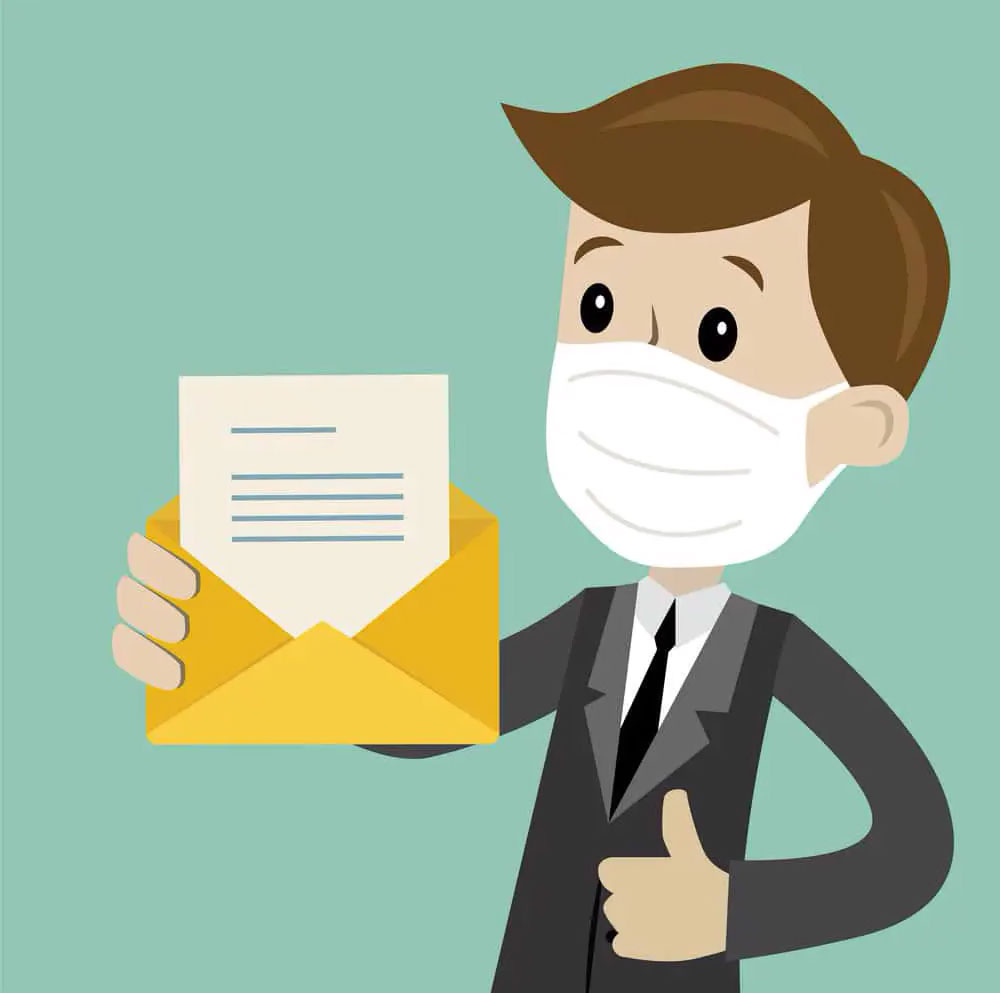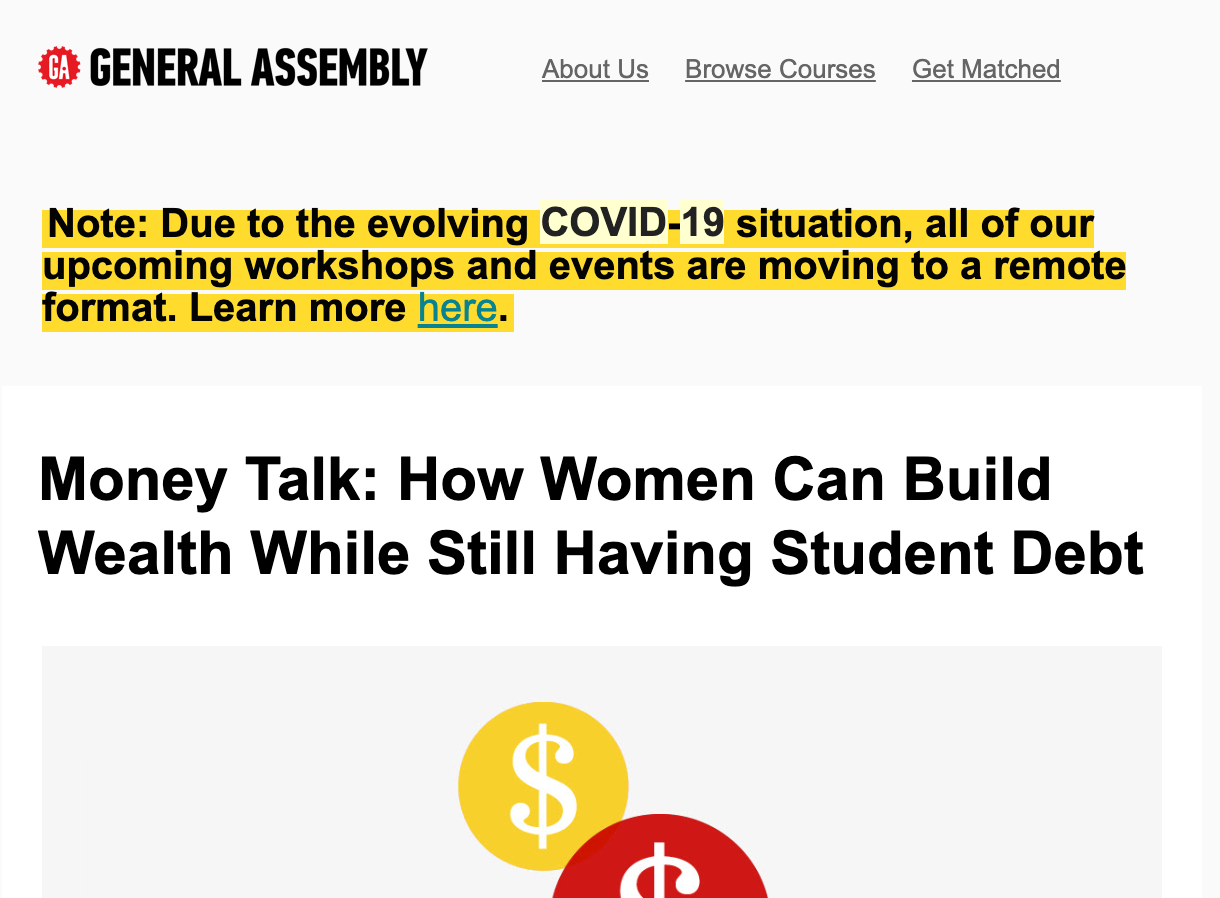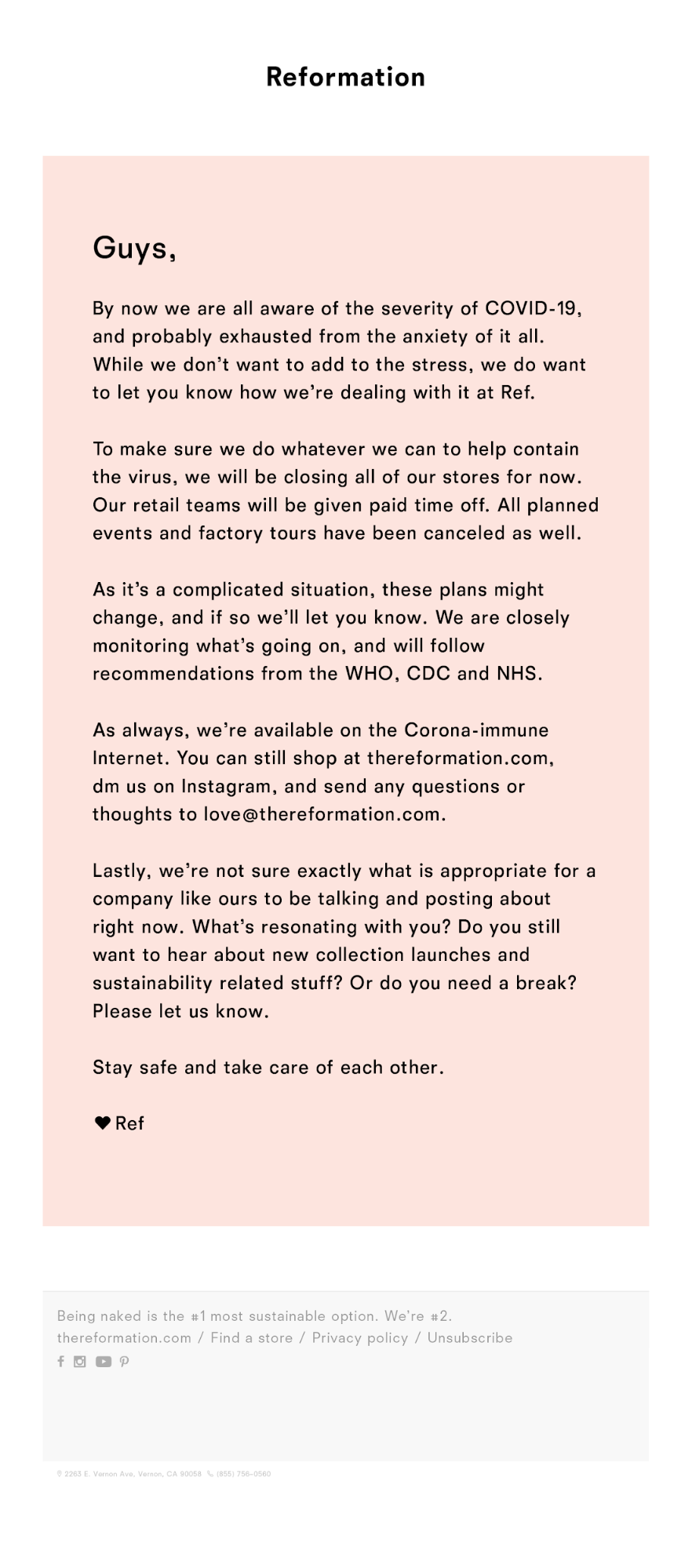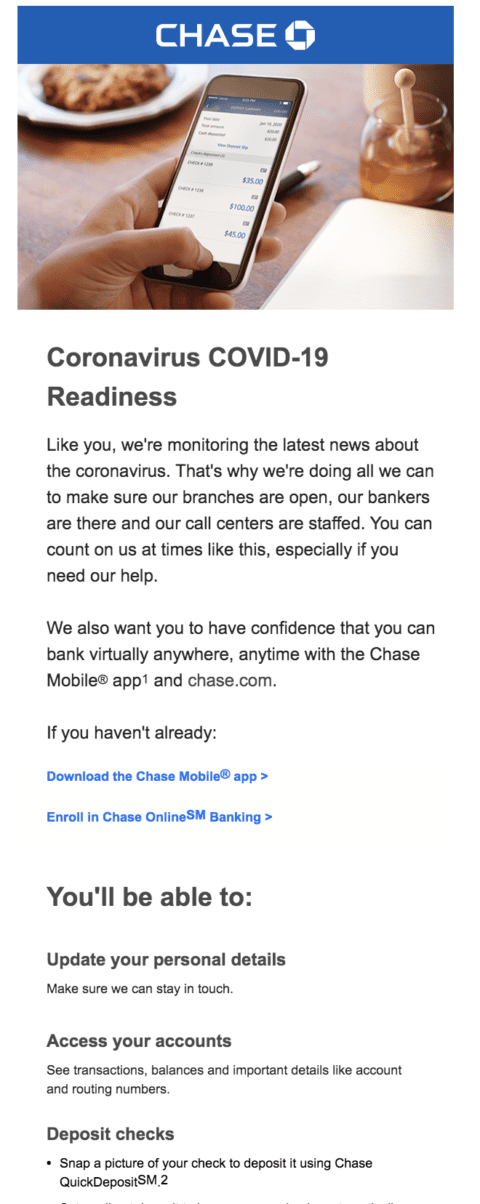Best Practices for Email Marketing During a Crisis
Right about now, people are being flooded with countless emails from their doctors, local grocery stores, online retailers, gyms, and even their veterinarians. All of these emails are about the coronavirus (COVID-19).
Both business leaders and marketers have to carefully assess whether their email marketing campaign is appropriate during these difficult times. For some of these individuals, a carefully-worded letter written by the CEO.
For others, these correspondences entail a casual update to inform an audience about a recent change in business hours. Ultimately, if your campaign isn’t optimized to leverage the correct angle and tone that’s relevant during this crisis, it could result in your emails being ignored.
You could also receive backlash from your subscribers, threatening or even willingly opting out of your email list. As you can see, devising the perfect email marketing campaign can be challenging.
To ease this burden on you, here are some ways you can overhaul your existing campaign in favor of an effective one for this time.
When Should I Send a COVID-19 Email?
Many businesses across the world have been affected by the coronavirus. Therefore, if your products and services have been affected by the COVID-19, you should definitely send an email to make an update.
Here are several sufficient reasons why sending a COVID-19 email would be beneficial for both you and the recipient.
- You have meaningful and useful information to provide.
- Your target audience is highly affected by this crisis (e. assisted living facilities informing relatives about their loved ones, therapists offering support to clients, etc).
- Your business has a physical location.
- Your products or services have been impacted in some way.
- You’re offering something to help your audience during this crisis, such as waiving cancellation costs, providing virtual solutions, and offering essential medical supplies and food.
As you can see, you should most likely be sending a COVID-19 email. Even if you are continuing your business like normal, you can’t expect your target audience to automatically assume this.
Nonetheless, there are certain conditions in which sending a COVID-19 email may not be ideal.
When Should I Not Send a COVID-19 Email?
For every great COVID-19 email, there are several that completely miss the mark. Before you schedule any emails regarding the coronavirus, make sure you know why you’re sending it and who these emails need to be sent to.
For example, just because someone purchased a product from you four weeks ago doesn’t mean that they want to know if you’re adding a new product to your online store or that you have changed your business hours.
With that said, here are the types of COVID-19 emails that may ruffle the feathers of your subscribers.
- Emails that serve no purpose rather than you trying to send something at the moment.
- Emails telling subscribers that the coronavirus will not impact your business.
- Emails informing subscribers that your office staff will work from home.
- Emails that don’t provide helpful or relevant information.
- Emails regurgitating information from other sources, in which you are qualified to speak on.
Again, people are receiving emails from many companies in regards to the coronavirus. It doesn’t make much sense, nor is it an effective marketing strategy, to send updates that aren’t important.
Best Practices for Sending COVID-19 Emails
Everyone has likely received dozens of COVID-19 emails by now. Some are very helpful and some just take up space in your inbox much to your annoyance. Since most people won’t take a lot of time to read these emails all the way through, it’s absolutely critical to ensure that your COVID-19 emails are both useful and engaging.
These are important times, and you want to be sure that everything you send out reflects your company well and gets read by your target audience. So, here are essential tips you should follow to enhance the performance of your email marketing campaign.
A strategy like this ensures that your audience is always updated on key changes to your business.
Only Send Useful Content
Marketing is all about trends, from SEO to email marketing. When a marketer sees that another successful marketer is doing something, they will likely catch on. This is an acceptable practice, and it’s even crucial at times, but during the COVID-19, you should only do what works for your company.
Don’t just send COVID-19 emails because other companies are doing it. If you’re going to send an email, make sure that it’s valuable to your audience. Popular COVID-19 emails include helpful tips for working at home, updates to important delivery and shipping information, and reminders of virtual service offerings.
Ultimately, you should think about what your customer wants to read first and what’s ideal for your business second if you want to determine the email you should send.
Create Skimmable Emails
Most COVID-19 emails contain a bunch of unformatted blocks of text that don’t indicate where the key points are. If your audience has to read an entire email just to learn something they already knew, they’ll be less interested in reading future emails from you.
When creating your emails, make sure that they are properly formatted with headers, spaced text, and bulleted key points. This will ensure that your emails are skimmable.
Keep All Emails Concise
The truth is that many COVID-19 emails contain a great deal of technical jargon and superfluous verbiage. With your subscribers being busy and possibly overwhelmed from this crisis, they would much rather enjoy a concise message that gets straight to the point.
If you want your email marketing campaign to be effective, get to point immediately with the topic you’re addressing, how you want to address it, why you want to address it, and how your audience can contact you with additional questions.
Make a Note About the Coronavirus in Future Emails
Depending on your circumstances, you may not need to send an individual email about the coronavirus. Instead, you can add a note at the top of your future emails to get your message across more conveniently.
In addition, you can include a note at the top of your individual COVID-19 email to quickly relay more essential information. For example, take a look at this email sent from General Assembly.
Ask Subscribers What They Think
There are so many businesses that send COVID-19, act like they are concerned, and continue on with their email marketing campaign like nothing ever happened. Honesty is the best policy in these types of situations.
If you aren’t sure how to proceed with your campaign, just let your subscribers know. Reformation made sure to announce their uncertainty with the next steps of their email campaign.
This company took the correct approach in asking their subscribers what they think.
This is an effective approach for getting down to the messages your audience wants to see. Clearly, doing this shows that you value the opinions of your target audience. This brings us to the next point.
Segment Your Emails According to Your Responses
Asking subscribers to comment on your email marketing strategy is only the beginning of making sure that their opinions matter. The purpose of any email campaign is to provide relevant content.
How can you achieve this when one subscriber asks that you limit their email frequency and another one requests that you continue to send sales emails? You can’t side with the majority in either case.
Instead, segmenting your email list based on the responses you receive is the perfect option. Make sure you are creating detailed segmentation for your email list, even if a few subscribers make up one single category.
While this will take a lot of time and effort to accomplish, you will go a long way in ensuring that all of your subscribers are receiving emails they will most likely engage with.
Cancel Other Campaigns That Don’t Make Sense
Creating a new email campaign can quickly have you lose sight of the old one you still have scheduled. In fact, most marketers forget to adapt their scheduled emails to fit the current climate.
If you have any emails that are insensitive or do not relate to your new strategy, cancel them immediately before they are sent out. For any businesses that have had large events planned, stop these posts before you make a critical mistake.
Spirit Airlines experienced this misstep the hard way when they sent out a previously scheduled email titled “Never a Better Time to Fly”.
Spirit Airlines later issued an apology for the mistake citing that they overlooked the email. If this can happen to a billion-dollar airline company, then it can also happen to you.
Furthermore, watch out for automated emails that encourage readers to visit your place of business. If you’ve recently announced your closure or changed your business hours, you don’t want to send mixed signals and confuse your audience. If you’ve recently announced your closure or changed your business hours, you don’t want to send mixed signals and confuse your audience. If your email campaign is extensive, it may take a lot of time to check for obsolete emails.
Master the Subject Line
Subject lines are arguably the most important aspect of any email campaign. A properly-written and enticing subject line will almost always be opened. Rightfully so, in a time like this when every company is sending a COVID-19 email, you want to make sure that yours stands out.
Since the coronavirus is a serious issue, there isn’t really a need to create eye-catching subject lines for your emails. Everyone already knows about the coronavirus, so even if you use the subject line “Our Response to COVID-19”, you’re bound to get the attention of your audience.
Also, one mistake that many brands tend to make when sending personal emails is changing the name of the sender. If your company CEO wants to inform their audience of a new update, don’t change the name of the sender to their name.
Frankly, unless this person is recognized by every person on the planet (Bill Gates, Oprah Winfrey, etc), then chances are that not all of your subscribers know this person. With that said, they will be less inclined to click on an email if they aren’t sure where it’s from.
Keep your sender name and email address the same for all of your emails to ensure that they are clicked on.
Adjust Your Brand Tone
Every company has a different brand tone. Some companies utilize a technical and matter-of-fact tone in their emails, while some are more free-spirited. Regardless of what your tone is, now is a great time to adjust your brand tone to become more fitting to the current situation.
Nonetheless, try not to utilize a dire and solemn tone for your emails. This will only increase the stress of your audience. Instead, openly acknowledge the anxiety of your readers and keep an objectively calm tone for all of your emails.
This will help your audience better digest the information your emails contain and make your brand seem more human.
Highlight What’s Important
What’s the point of your COVID-19 email? Many of these emails include some sort of update regarding ways your business will meet the needs of your audience. If so, make these updates clear by only highlighting what’s important.
After all, your recipients are going to be most interested in what you have to offer in servicing them during this crisis. Are you using new resources to make sure that your building is deep cleaned every day?
This is the type of information your audience wants to know. Chase Bank provided a wonderful example of an email that shows customers how they can bank online.
This email perfectly outlines what Chase Bank is doing to make banking easier for remote transactions. This is perfect for readers who prefer to skim emails.
Craft the Best COVID-19 Email Today!
There are a lot of considerations to take into account before sending your COVID-19 email. Remember that all brands are different and that you must only do what works for your audience.
Still, these tips will help you craft the best emails that provide value to your audience and keep them engaged throughout the span of the coronavirus pandemic.






